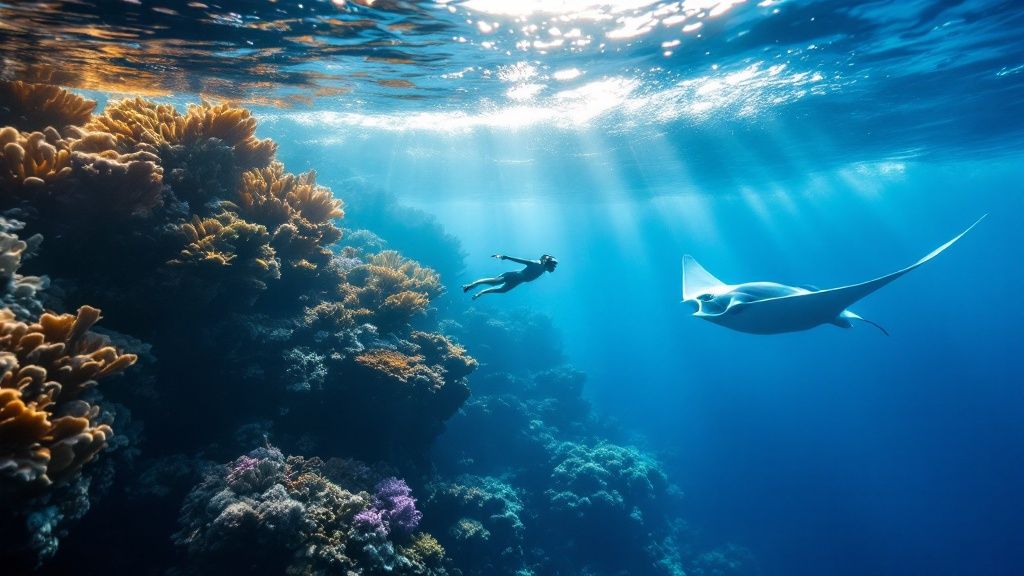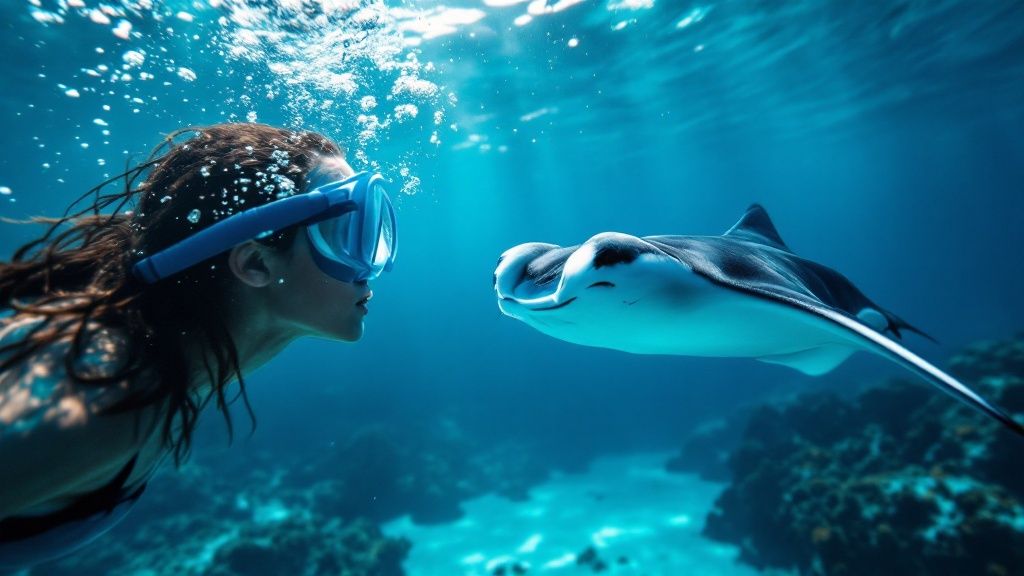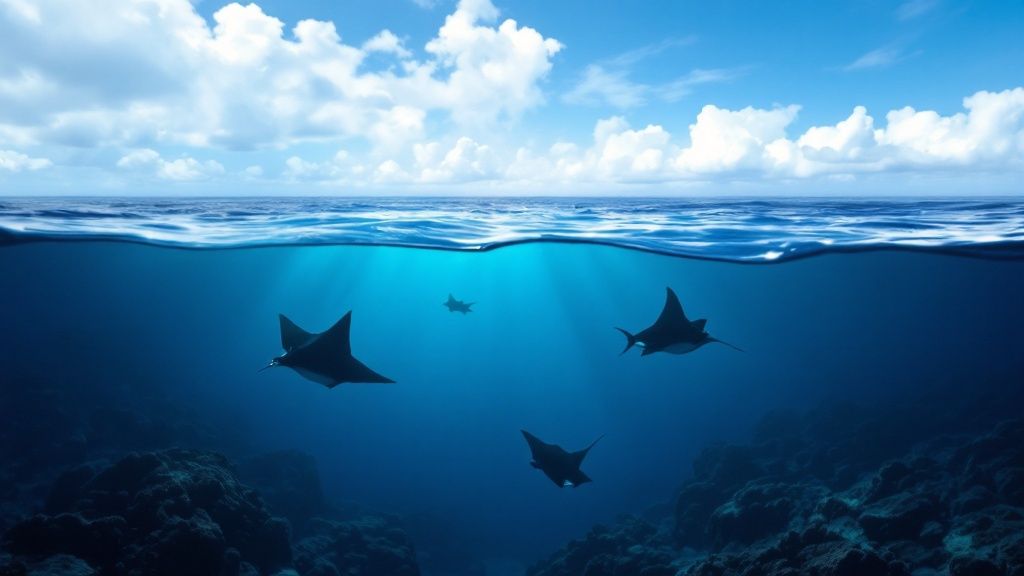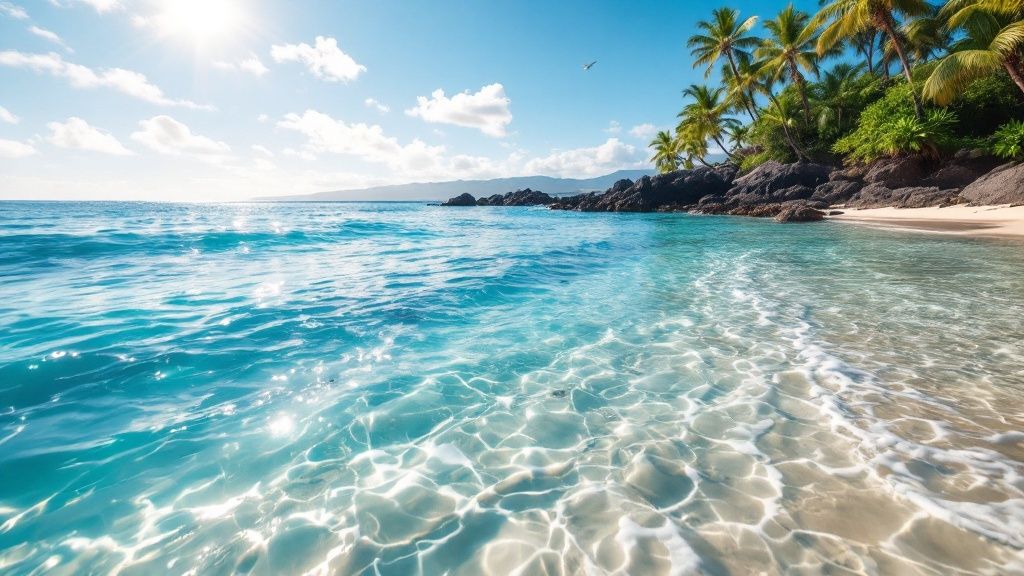Snorkeling with Manta Rays Kona: Dive into Adventure
- Byron
- Mar 16
- 10 min read
The Mesmerizing World of Kona's Manta Ray Night Dives
Imagine floating in the dark Pacific, stars twinkling above. Suddenly, a graceful giant emerges from the depths, its wings spanning up to 14 feet, illuminated by soft underwater lights. This is the magic of snorkeling with manta rays in Kona, an unforgettable experience for any adventurer.
The Underwater Ballet of Gentle Giants
Kona's unique ecosystem is the perfect setting for this remarkable encounter. The volcanic slopes of the Big Island create nutrient-rich waters, attracting large amounts of plankton, the manta ray's main food source. Underwater lights, placed by tour operators, enhance this natural buffet, drawing the mantas closer to the surface. This allows for an up-close view of their feeding rituals, often just inches below you. They perform captivating underwater ballets, gracefully looping and swirling as they consume the tiny organisms.
Kona: A Manta Ray Mecca
This incredible spectacle has made Kona a global destination for manta ray enthusiasts. Snorkeling with manta rays in Kona, Hawaii, is a highly sought-after activity, attracting thousands of people yearly. Around 80,000 people participate in manta ray snorkeling or diving annually, contributing significantly to local tourism. Find more detailed statistics here. The remarkable 80-90% sighting success rate, due to the thriving manta ray population, further cements Kona's status as a must-see for nature lovers. This high rate is attributed to the unique ecosystem and consistent plankton presence, ensuring almost year-round sightings. You might also be interested in: Our blog post sitemap for more information.

An Accessible Adventure for All
What truly sets this experience apart is its accessibility. Whether you're an experienced diver or a beginner snorkeler, the calm waters and the mantas' proximity create an unforgettable encounter. Even non-swimmers can participate, viewing these gentle giants from a boat. The experience is designed to be both exciting and informative, with knowledgeable guides sharing information about the biology and behavior of these magnificent creatures. This combination of wonder and accessibility makes snorkeling with manta rays in Kona a truly special experience, connecting people with the ocean in a profound way. This is a must-do for anyone visiting the Big Island, offering a memorable encounter with one of the ocean’s most graceful inhabitants.
Prime Manta Viewing Locations: Insider's Guide to Kona Spots

Planning a manta ray snorkeling trip in Kona? Not all experiences are created equal. Each site offers a unique perspective on these magnificent creatures. This guide will help you choose the perfect spot for your underwater adventure.
Manta Village Vs. Manta Heaven: A Comparison
Two popular Kona locations are Manta Village (Kaukalaelae) and Manta Heaven (Keauhou Bay). Each offers a distinct experience. Manta Village, near the Sheraton Kona Resort, boasts a shallow, sandy bottom. This is perfect for watching mantas perform their graceful feeding rituals. Plus, larger groups of mantas often gather here, boosting your chances of a truly spectacular encounter.
Manta Heaven, nestled in Keauhou Bay, provides a different kind of charm. The bay's sheltered waters are generally calmer. This makes it ideal for families with young children or those seeking a more relaxed experience. The calmer waters also typically offer increased visibility, leading to breathtaking photo opportunities.
To help you decide which location best suits your needs, here’s a handy comparison table:
Top Manta Ray Snorkeling Locations in Kona: Comparison of the main manta ray viewing sites in Kona, including success rates, best times to visit, and unique features.
Location | Success Rate | Best Time | Depth | Special Features |
|---|---|---|---|---|
Manta Village | High | Year-round | 10-20 feet | Larger manta groups, sandy bottom |
Manta Heaven | High | Year-round | 20-30 feet | Calmer waters, better visibility |
As you can see, both locations offer excellent chances to see these gentle giants. The best choice depends on your priorities: more mantas or calmer waters.
Manta Ray Behavior and Ideal Conditions
Manta ray behavior varies based on location and season. At Manta Village, mantas often perform acrobatic displays, including backflips and barrel rolls while feeding. At Manta Heaven, the mantas tend to feed more leisurely, gliding gracefully through the illuminated waters.
Water conditions impact the overall snorkeling experience. While mantas can be seen year-round, summer typically offers calmer seas and better visibility. Interestingly, manta ray sightings in Kona have been carefully documented. Research from 2009 to 2014 tracked individual mantas at both locations using their unique spot patterns. Find more detailed statistics here. This research helps understand their behavior and the effects of tourism.
Streamlining Your Manta Ray Adventure: Departure Points and Travel Times
Maximize your vacation time by choosing the right departure point. Most manta ray tours depart from Honokohau Harbor or Keauhou Bay. Travel times vary from Kona accommodations. If you're staying in Kailua-Kona, Honokohau Harbor might be more convenient. If you’re closer to Keauhou, departing from Keauhou Bay will minimize travel time. Careful planning ensures more time enjoying the magic of snorkeling with manta rays.
Selecting Your Perfect Manta Experience: Beyond Basic Tours

With so many tour operators offering snorkeling with manta rays in Kona, choosing the right one can feel overwhelming. But this isn't just another item to check off your bucket list. It's about creating a truly memorable experience while respecting these magnificent creatures and their environment.
Key Factors to Consider
Finding the perfect manta ray tour involves more than just clicking the first search result. Take some time to think about what you really want from your encounter.
Group Size: A smaller group often translates to a more personalized and intimate experience. Larger groups can feel crowded, making it harder to observe the natural behavior of the manta rays. Ideally, aim for a tour with a maximum of 10-15 people.
Guide Expertise: Guides with a background in marine biology can enrich your experience significantly. They'll provide valuable insights, turning your trip into an educational adventure. This expert knowledge adds depth and understanding to your manta ray encounter.
Equipment Quality: Comfortable, well-maintained equipment is essential for a safe and enjoyable nighttime ocean activity. Be sure to check reviews and ask about the provided wetsuits, snorkels, and flotation devices.
Operator Ethics: Choose operators dedicated to manta ray welfare and conservation. Look for certifications or memberships in organizations like the Manta Pacific Research Foundation. Supporting ethical operators ensures the long-term health of the manta ray population.
Tailoring Your Trip: Specific Needs and Preferences
Consider your individual needs and any potential concerns to further refine your choice.
Families with Young Children: Select operators with experience working with young snorkelers. Prioritize tours that emphasize safety and offer extra attention to younger participants.
Seniors or Those with Mobility Limitations: Ensure the tour is appropriate for your physical abilities. Discuss any concerns with the operator beforehand, and inquire about accessibility features on the boat and in the water.
Anxious Swimmers: A smaller, more supportive environment can ease anxieties. Look for operators known for their patient and understanding staff. A smaller group and a reassuring guide can make a significant difference. Consider reaching out to operators directly to discuss your specific needs. You might be interested in: Our sitemap for more detailed information.
Choosing the Right Tour: A Comparison
To help you choose the perfect tour, we've created a comparison table outlining the key differences between a few common options. This table summarizes group size, price range, and other important factors to consider.
Manta Ray Tour Types Comparison: Compare different tour options for snorkeling with manta rays in Kona.
Tour Type | Group Size | Price Range | Duration | Pros | Cons | Best For |
|---|---|---|---|---|---|---|
Basic Tour | 20-40 | $100-$150 | 2-3 hours | Affordable, readily available | Less personalized attention, larger groups | Budget-conscious travelers |
Enhanced Tour | 10-20 | $150-$250 | 3-4 hours | Smaller groups, more experienced guides, often includes extras like photos or refreshments | More expensive than basic tours | Those seeking a more in-depth experience |
Private Charter | Customizable | $500+ | Flexible | Highly personalized, exclusive experience, customizable itinerary | Most expensive option | Families, small groups, special occasions |
This table provides a quick overview of the various tour options. Remember to always research specific operators and read reviews before making your final decision.
Beyond the Basics: Enhancing Your Manta Magic
Beyond the standard tours, you'll find specialized options catering to specific interests. Photographers might prefer tours focused on capturing stunning images. Others might enjoy sunset views or combined whale watching opportunities. For a truly exclusive experience, some companies even offer private charters. Understanding these nuances allows you to select the perfect match for your desires, creating a truly unforgettable snorkeling with manta rays Kona adventure.
Timing Your Manta Adventure: Beyond Basic Seasonality

While snorkeling with manta rays in Kona is possible throughout the year, understanding the subtle seasonal differences can greatly improve your experience. It's not simply about dodging rain showers; it's about syncing your trip with the right conditions. Whether you prioritize clear water for stunning photos or calm seas for a family outing, timing is everything.
Lunar Cycles and Plankton: The Manta Magnet
The moon's cycle heavily influences plankton blooms, the manta ray's primary food source. A full moon, while visually appealing, can reduce visibility due to the higher concentration of plankton. However, this also translates to increased manta ray activity. This presents a unique challenge for photographers: more mantas under a brighter moon, but potentially murkier water for capturing those ideal shots. Conversely, a new moon typically results in clearer water, possibly at the expense of fewer manta ray sightings.
Optimal Windows for Different Preferences
For families with young children or those who prefer calmer waters, the summer months (April to October) generally offer smoother seas. This also coincides with the dry season, minimizing the chance of rain impacting your Kona manta ray snorkel trip. However, this is the busiest time of year, so booking your tour well in advance is essential.
Photographers aiming for optimal visibility should consider visiting during a new moon or during the shoulder seasons (April-May or September-October). While manta ray sightings might be less frequent, the clearer water offers incredible photo opportunities.
Beyond the Crowds: Discovering Hidden Gems
Certain months offer distinct viewing experiences. For instance, some periods have a higher concentration of young manta rays, providing a unique perspective on these gentle giants. Some experienced guides also report longer manta ray interactions during particular times of the year, enhancing the value of your snorkeling adventure. These hidden gems are often missed by the average tourist, but understanding these subtle seasonal variations can truly optimize your experience.
Maximizing Your Manta Magic
By considering the interplay of lunar cycles, seasons, and tourist traffic, you can tailor your trip to perfectly match your priorities. This insider knowledge can transform a good experience into an unforgettable one, ensuring you witness the magic of Kona's manta rays in a way that truly resonates with you. Whether you're after calm waters, pristine visibility, or extended encounters, strategic timing is key.
Preparation Mastery: Setting Yourself Up for Manta Success
The difference between a frustrating experience and a truly magical manta ray encounter in Kona often comes down to preparation. This isn't simply about remembering your swimsuit; it's about ensuring you're physically and mentally ready for this unique nighttime ocean adventure. This guide will help you maximize your manta magic.
Conquering Seasickness: Tips from the Pros
Even on calm waters, the gentle rocking of a boat at night can sometimes cause seasickness. Dramamine can be helpful, but some lesser-known strategies can enhance its effectiveness. Eating a light meal a few hours before the tour can settle your stomach. Ginger, in candy or tea form, is a natural remedy that many find helpful. Focusing on the horizon or a distant fixed point can also minimize disorientation and reduce nausea.
Camera Ready: Capturing the Magic in Low Light
Many people want to capture the beauty of manta rays, but underwater photography in low light can be tricky. GoPro cameras tend to handle low-light conditions well. A red filter can help correct color distortion caused by water and artificial lights. Make sure your camera is securely attached to a float or wrist strap – dropping it in the dark ocean would definitely ruin the experience. Remember to hold your camera close, avoid contact with the manta rays, and respect their space.
Essential Gear vs. Unnecessary Clutter: Packing Smart
Most reputable tour operators provide high-quality snorkel gear. Bringing your own often adds unnecessary weight. However, if you have a mask you find especially comfortable, it might be worth it. Remember, the most important things to bring are your positive attitude and sense of adventure! A towel and a change of clothes are essential for warming up afterward, and layers are helpful for managing temperature changes.
Addressing First-Time Anxieties: Night Snorkeling Made Easy
Entering the ocean at night can be intimidating for some. Rest assured, reputable manta ray tours prioritize safety. Guides stay with the group, offering support and reassurance. Underwater lights, used to attract plankton, also illuminate the area, improving visibility. If you're still hesitant, some tours offer the option to observe from the boat, providing a great view of the manta rays.
Building Confidence in the Water: Pre-Trip Preparation
If you're a less experienced swimmer, pre-trip practice can build confidence. Spending time in a pool or calm shallow water can familiarize you with using a snorkel and fins. Practicing floating and treading water can also help you feel more comfortable in the ocean. Finally, communicating any concerns with your tour guides can ease anxieties. They are there to support you and ensure a safe and positive experience. By understanding these preparation tips, snorkeling with manta rays in Kona will become a truly unforgettable adventure.
Beyond Tourism: Your Role in Manta Ray Conservation
Snorkeling with manta rays in Kona is an unforgettable experience. But it's more than just a vacation highlight. It's a chance to contribute to the conservation of these gentle giants. This perspective shifts your adventure from simple entertainment to meaningful participation in preservation.
How Tourism Helps Manta Rays
Thoughtful tourism plays a vital role in protecting manta rays. By creating economic incentives for conservation, local communities become invested in safeguarding these creatures and their habitat. The thriving tourism industry in Kona, for instance, directly benefits from the presence of manta rays. This motivates businesses and individuals to support conservation efforts. Your choice of tour operator has a direct impact. Selecting operators committed to sustainable practices strengthens this positive feedback loop. This economic benefit highlights the importance of responsible tourism for the long-term survival of these magnificent animals. The economic impact of manta ray tourism in Kona is substantial, supporting local businesses and related services. Explore this topic further.
Choosing Responsible Operators
Not all tour operators are the same. Some genuinely contribute to research and conservation, while others fall short. Look for operators actively involved in research initiatives, employing marine biologists, and adhering to strict guidelines for responsible interaction. These operators often collaborate with organizations dedicated to manta ray research and advocacy, providing valuable data and resources.
Citizen Science: Making Your Trip Count
You can contribute directly to manta ray research through citizen science programs. Many operators encourage guests to participate in data collection, like identifying individual manta rays by their unique spot patterns. This information helps researchers track population dynamics, monitor manta health, and understand their behavior. Taking photos and submitting them to online databases, for example, helps expand existing catalogs and contributes to ongoing research. Check out our guide on blog categories for more information.
Responsible Interaction Guidelines: Ensuring Future Encounters
Protecting manta rays for future generations depends on responsible interaction during your snorkeling experience. Here are some key guidelines:
Maintain a safe distance: Avoid touching or chasing manta rays, allowing them to swim and feed naturally.
Control your movements: Minimize splashing and sudden movements to avoid startling them.
Respect their space: Don't obstruct their path or crowd them, especially while they are feeding.
Refrain from flash photography: Bright flashes can disorient and stress the mantas.
From Tourist to Conservationist
By understanding the balance between appreciation and preservation, you can transform your snorkeling with manta rays in Kona from passive observation into an active contribution to their survival. Your informed choices and responsible actions directly support conservation efforts, ensuring future generations can experience these gentle giants. Ready for a truly meaningful manta ray adventure? Book your tour today with Manta Ray Night Snorkel Kona Hawaii Tours and experience the magic while contributing to their conservation.
Comentarios